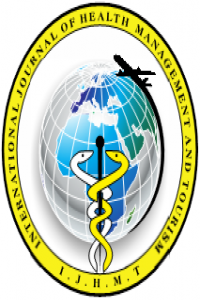THE CONTENT OF TWITTER MESSAGES OF DIFFERENT HEALTH GROUPS: THE ROLE OF SOCIAL MEDIA IN HEALTH
THE CONTENT OF TWITTER MESSAGES OF DIFFERENT HEALTH GROUPS: THE ROLE OF SOCIAL MEDIA IN HEALTH
Twitter, Social Media, Private Health Group,
___
- Adams, S. A., Van Veghel, D., & Dekker, L. (2015). Developing a research agenda on ethical issues related to using social media in healthcare: Lessons from the first Dutch Twitter heart operation. Cambridge Quarterly of Healthcare Ethics, 24(3), 293-302.
- Allen, C. G., Andersen, B., Khoury, M. J., & Roberts, M. C. (2018). Current Social Media Conversations about Genetics and Genomics in Health: A Twitter-Based Analysis. Public Health Genomics, 21(1-2), 93-99. doi:10.1159/000494381
- Borgmann, H., Loeb, S., Salem, J., Thomas, C., Haferkamp, A., Murphy, D. G., & Tsaur, I. (2016). Activity, content, contributors, and influencers of the twitter discussion on urologic oncology. Paper presented at the Urologic Oncology: Seminars and Original Investigations.
- Chisholm, E., & O’Sullivan, K. (2017). Using Twitter to Explore (un) Healthy Housing: Learning from the# Characterbuildings Campaign in New Zealand. International journal of environmental research and public health, 14(11), 1424.
- Choo, E. K., Ranney, M. L., Chan, T. M., Trueger, N. S., Walsh, A. E., Tegtmeyer, K., McNamara, S.O., Choi, R.Y. & Carroll, C. L. (2015). Twitter as a tool for communication and knowledge exchange in academic medicine: a guide for skeptics and novices. Medical teacher, 37(5), 411-416.
- Eckler, P., Worsowicz, G., & Rayburn, J. (2010). Social media and healthcare: an overview. PM&R, 2(11), 1046-1050.
- Gabarron, E., Dorronzoro, E., Rivera-Romero, O., & Wynn, R. Diabetes on Twitter: A Sentiment Analysis. Journal of Diabetes Science and Technology, 0(0), 1932296818811679. doi:10.1177/1932296818811679
- Giustini, D., Ali, S. M., Fraser, M., & Boulos, M. N. K. (2018). Effective uses of social media in public health and medicine: a systematic review of systematic reviews. Online Journal of Public Health Informatics, 10(2).
- Gomes, C., & Coustasse, A. (2015). Tweeting and treating: how hospitals use twitter to improve care. The health care manager, 34(3), 203-214.
- Grajales III, F. J., Sheps, S., Ho, K., Novak-Lauscher, H., & Eysenbach, G. (2014). Social media: a review and tutorial of applications in medicine and health care. Journal of medical Internet research, 16(2).
- Griffis, H. M., Kilaru, A. S., Werner, R. M., Asch, D. A., Hershey, J. C., Hill, S., Ha, Y.P., Sellers, A., Mahoney, K. & Merchant, R. M. (2014). Use of social media across US hospitals: descriptive analysis of adoption and utilization. Journal of medical Internet research, 16(11).
- Hawkins, J. B., Brownstein, J. S., Tuli, G., Runels, T., Broecker, K., Nsoesie, E. O., Mclver, D.J., Rozenblum, R., Wright, A., Bourgeois, F.T. & Bourgeois, F. T. (2016). Measuring patient-perceived quality of care in US hospitals using Twitter. BMJ Qual Saf, 25(6), 404-413.
- Hoffman, D. L., & Fodor, M. (2010). Can you measure the ROI of your social media marketing? MIT Sloan Management Review, 52(1), 41.
- Menzies, S., Daly, S., & McKenna, D. B. (2018). Social media and psoriasis treatment: what are people saying on Twitter? Br J Dermatol. doi:10.1111/bjd.17452
- Moorhead, S. A., Hazlett, D. E., Harrison, L., Carroll, J. K., Irwin, A., & Hoving, C. (2013). A new dimension of health care: systematic review of the uses, benefits, and limitations of social media for health communication. Journal of medical Internet research, 15(4).
- Neiger, B. L., Thackeray, R., Burton, S. H., Giraud-Carrier, C. G., & Fagen, M. C. (2013). Evaluating social media’s capacity to develop engaged audiences in health promotion settings: use of Twitter metrics as a case study. Health promotion practice, 14(2), 157-162.
- Park, H., Rodgers, S., & Stemmle, J. (2013). Analyzing health organizations' use of Twitter for promoting health literacy. Journal of health communication, 18(4), 410-425.
- Pershad, Y., Hangge, P., Albadawi, H., & Oklu, R. (2018). Social medicine: Twitter in healthcare. Journal of clinical medicine, 7(6), 121.
- Sinnenberg, L., Buttenheim, A. M., Padrez, K., Mancheno, C., Ungar, L., & Merchant, R. M. (2017). Twitter as a tool for health research: a systematic review. American journal of public health, 107(1), e1-e8.
- Terry, M. (2009). Twittering healthcare: social media and medicine. Telemedicine and e-Health, 15(6), 507-510.
- Thompson, M. A., Majhail, N. S., Wood, W. A., Perales, M.-A., & Chaboissier, M. (2015). Social media and the practicing hematologist: Twitter 101 for the busy healthcare provider. Current hematologic malignancy reports, 10(4), 405-412.
- Tsuya, A., Sugawara, Y., Tanaka, A., & Narimatsu, H. (2014). Do cancer patients tweet? Examining the twitter use of cancer patients in Japan. Journal of medical Internet research, 16(5).
- Ventola, C. L. (2014). Social media and health care professionals: benefits, risks, and best practices. Pharmacy and Therapeutics, 39(7), 491.
- Yayın Aralığı: Yılda 3 Sayı
- Başlangıç: 2016
- Yayıncı: Dilaver TENGİLİMOĞLU
PATIENT EXPECTATIONS AND SATISFACTION IN HEALTH TOURISM EXAMPLE OF A PRIVATE HOSPITAL GROUP
Begüm YALÇIN, Rukiye ÇELİK, Şerife Alev UYSAL
THE CONTENT OF TWITTER MESSAGES OF DIFFERENT HEALTH GROUPS: THE ROLE OF SOCIAL MEDIA IN HEALTH
Birke BULU, Fedayi YAĞAR, Büşra KOPMAZ, Nur ŞİŞMAN KİTAPÇI, Okan Cem KİTAPÇI, Pınar KILIÇ AKSU, Leyla KÖKSAL, Gonca MUMCU
CAUSES OF MATERNAL MORTALITY IN NIGERIA; A SYSTEMATIC REVIEW
Saima TASNEEM, Adaugo NNAJI, Macide ARTAC OZDAL
GLOBAL BURDEN OF DISEASE: A BIBLIOMETRIC ANALYSIS BASED ON THE SCOPUS DATABASE
